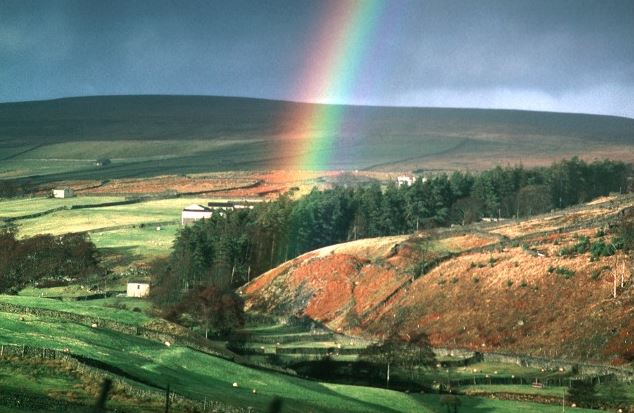Social Science
Oral History Center Presents Work at NCPH in Utah and Explores “Belonging” in Japanese American History
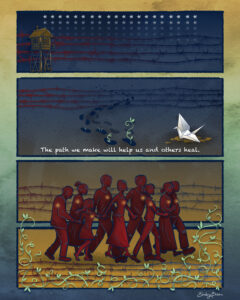
In April 2024, Oral History Center (OHC) interviewers Amanda Tewes, Shanna Farrell, and Roger Eardley-Pryor traveled to Salt Lake City, Utah, where we presented our work on the Japanese American Intergenerational Narratives Project at the annual meeting of the National Council on Public History (NCPH). We also joined a pilgrimage to the central desert of Utah along with other public historians and several members of the Wakasa Memorial Committee, including survivors and descendants of the Topaz prison camp in Utah, one of the ten US government mass incarceration sites where Japanese Americans were unjustly imprisoned during World War II. Our experiences in Utah at NCPH and at Topaz reiterated how history remains a powerful and living force, and how oral history can help promote that power. Difficult questions about “belonging” appear throughout many of the oral histories in OHC’s Japanese American Intergenerational Narratives project, and those same questions punctuated much of our time in Utah this past April.
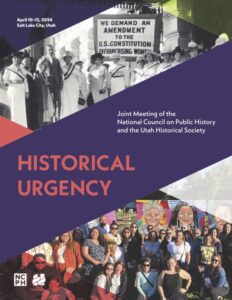
“Historical Urgency” was the conference theme for this year’s meeting of the National Council on Public History (NCPH) in Salt Lake City, where some 740 attendees presented, networked, and learned together. Presentation topics included community engagement, particularly with communities whose histories face urgent existential threats; communicating the critical importance of history and historical thinking; discourse and dialogue in a time of extreme social polarization; exploration of oral history, especially the collection of oral histories from older generations; and repatriation of human remains and cultural objects. As noted by NCPH president Kristine Navarro-McElhaney, conference discussions highlighted how historians’ work for public audiences remains essential to the fabric of our society, especially during this time of political and cultural polarization—and yet historical perspectives, tools, and history workers themselves have increasingly come under threat. While urgency may seem in opposition to the often slow and deliberate work that oral historians and other public historians do to build trust and lasting relationships with the communities we serve, many of us cannot help but feel a strong sense of urgency and importance in our efforts to collaboratively excavate the past and elevate community stories in ways that help make meaning in the present.
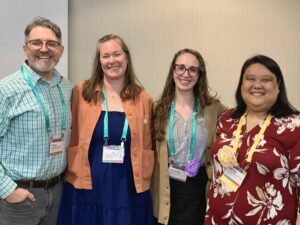
We felt especially honored to share at this NCPH our work on the Japanese American Intergenerational Narratives Project. Our roundtable presentation recounted the project’s origins, the trauma-informed interviewing approach we used with these oral histories, and some of emergent themes from the project’s interviews, like “belonging,” “art and expression,” “healing,” and “memorialization.” The roundtable’s discussion was moderated by Hanako Wakatsuki-Chong, the Executive Director of the Japanese American Museum of Oregon and a former National Park Service Ranger who recorded her own oral history as part of the project. Nancy Ukai and Masako Takahashi, both of whom also recorded oral histories as part of the project, attended and also presented at the NCPH conference in Utah, where they heard portions their own oral history interviews during our presentation. Our presentation included audio clips from season 8 of The Berkeley Remix podcast, “From Generation to Generation”: The Legacy of Japanese American Incarceration,” as well as graphic narrative artwork by Emily Ehlen, all based on oral histories recorded for the Japanese American Intergenerational Narratives Project.
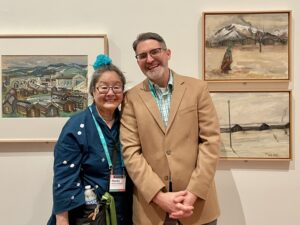
Relatedly, during the NCPH conference, I (Roger Eardley-Pryor) joined other public historians for a tour of the Utah Museum of Fine Arts on the University of Utah campus to see a new exhibit titled Pictures of Belonging: Miki Hayakawa, Hisako Hibi, and Miné Okubo. The exhibition was curated by Professor ShiPu Wang of UC Merced and features over 100 paintings and works on paper by these three Japanese American women artists, all critically acclaimed with long and productive careers. Yet during World War II, both Hibi and Okubo were unjustly incarcerated in Utah at Topaz, along with Hayakawa’s parents. Pictures of Belonging follows the three artists’ prewar, wartime, and postwar art practices, sharing an expanded view of the American experience by women who used artmaking to take up space, make their presence and existence visible, and assert their own belonging. Many of the exhibit’s artworks are on view to the public for the first time. The exhibit’s titular theme of “belonging” resonated nicely with the Oral History Center’s Japanese American Intergenerational Narratives Project at UC Berkeley, and Okubo even earned her Master in Fine Arts degree in 1938 from UC Berkeley. Our tour of the art exhibit was co-led by Sarah Palmer, Head Exhibition Designer at the Utah Museum of Fine Arts, and by Dr. Kristen Hayashi, Director of Collections Management & Access and Curator at the Japanese American National Museum in Los Angeles. I am especially grateful I could tour Pictures of Belonging with Masako Takashashi, who herself is an outstanding multi-media artist, was born behind barbed wire at the Topaz prison camp in Utah, and who I worked with to record her forthcoming oral history interview for the Japanese American Intergenerational Narratives Project.
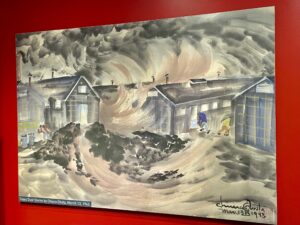
Our visit to the Utah Museum of Fine Arts also included another new exhibit titled Chiura Obata: Layer by Layer, which presents an in-depth look at the creation and conservation of Obata’s beautiful “Horses” silk screen painting from 1932. Chiura Obata was an esteemed artist and professor at UC Berkeley who was also incarcerated during World War II at Topaz in Utah, where he and Miné Okubo taught art classes for their fellow Japanese American incarcerees. Kimi Kodani Hill, the granddaughter of Chiura Obata, recently presented at the Utah Museum of Fine Arts on her grandfather’s life and work, and I’m grateful that during our recent meeting in Berkeley, prior to my own Utah trip, she shared stories with me about Obata’s silk screen exhibit. During the screen’s 2022 conservation treatment, conservators at Nishio Conservation Studio discovered that the four-paneled screen contained hidden full-scale preparatory charcoal drawings of the horses. In addition, they found that the screen’s internal layers were made of practice drawings by Professor Obata and his summer 1932 students. The recently conserved screen, the full-scale under-drawings, and a selection of the practice drawings were all on display at the Utah Museum of Fine Arts, along with a short film on the conservation process, which itself is an artform. After we returned to the Bay Area, Kimi Kodani Hill provided a guided tour of another exhibition with forty of Chiura Obata’s watercolors, woodblock prints, and ink paintings from several decades of his life that are currently displayed through mid-July at the San Francisco Museum of Modern Art.
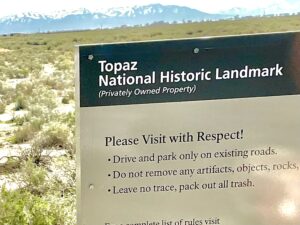
On April 11, 2024, in Salt Lake City at the NCPH conference, Masako Takahashi and Nancy Ukai joined other members of the Wakasa Memorial Committee to present their own panel titled “Who Writes Our History?” This panel explored the life and tragic death of James Hatsuaki Wakasa, who was shot and killed while confined in Topaz eighty-one years earlier on April 11, 1943. Their panel also addressed urgent and ongoing challenges over descendant and survivor community consent and collaboration with the Topaz Museum following the recent discovery and excavation of the Wakasa Memorial Stone from the Topaz incarceration site in 2021. That massive, 1,000-pound stone memorial was erected in 1943 by Japanese American incarcerees at Topaz just after James Wakasa’s murder there. But US government authorities quickly demanded the memorial’s destruction in their effort to bury acknowledgement of Wakasa’s death from a bullet fired by a white, nineteen-year-old US soldier who was quickly acquitted of any crime. The Wakasa Memorial Committee’s NCPH presentation, which was standing-room only, featured short films and personal reflections on the life, death, memory, and now-contested stone memorial of James Wakasa.
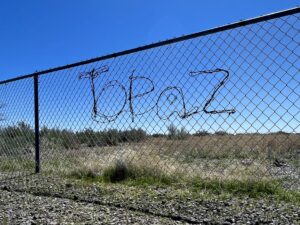
Two days later, still in Utah, Oral History Center interviewers and several other public historians joined Ukai, Takahashi, and other members of the Wakasa Memorial Committee on a pilgrimage to the dust-strewn ruins of the Topaz site on the edge of the Great Basin in Utah’s central desert. The bus ride out to the remote site included watching historical films and sharing personal backgrounds and reflections amongst this group that had assembled from eight different states. Hours later, we arrived at a sparse, sun-bleached landscape encircled by distant snow-capped mountains. Much of the original barbed wire fence around Topaz remains today where some 8,000 Americans were unjustly imprisoned for years during World War II. Crumbled concrete foundations mark sites of now-gone guard towers where US soldiers aimed their guns down at the Japanese American prisoners, and from where they occasionally fired shots, like the one that pierced James Wakasa’s heart in 1943. At the Topaz site, we joined members of the Topaz Museum Board, including board president Patricia Wakida; Scott Bassett, board secretary and education director at the Topaz Museum; and Topaz descendant and board member Dianne Fukami. Together, we all participated in a ceremony organized by the Wakasa Memorial Committee to commemorate Wakasa’s death, as well as the 140 people who died behind barbed wire at Topaz, and the sixteen Japanese American soldiers drafted from Topaz who died during their World War II military service.
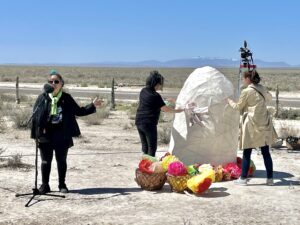
The Wakasa 81st Memorial Ceremony at Topaz began at block 36-7-D, where James Wakasa’s tar-paper barracks once stood. From there, we re-traced Wakasa’s steps across the dusty and now-hauntingly empty landscape to the western perimeter site of his murder, near where the Wakasa Memorial Stone once stood before incarcerated Japanese Americans, under government orders to destroy the memorial, buried it in 1943. An artist’s large recreation of the stone, this one blazing white and made of paper mache and wood, stood near the former burial site of the stone memorial before its removal in 2021. After a land blessing and words of remembrance from survivors born at Topaz, we encircled the artist’s stand-in memorial with name tags bearing the names of our own ancestors. Joshua Shimizu then sang in both Japanese and English the hymn “Rock of Ages,” which was also sung at Wakasa’s funeral in April 1943, and which offered deeper meaning for the missing original Wakasa Memorial Stone.
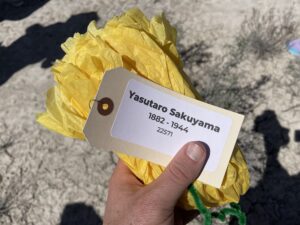
During the “Rock of Ages” hymn, ceremonial participants attached to the base of the art installation many colorful paper flowers that carried tags naming other Japanese Americans who died in Topaz. The paper flowers we carried to the ceremony were made by Topaz survivors and descendants in honor of the paper floral blossoms folded by imprisoned Japanese Americans at Topaz in lieu of actual flowers for James Wakasa’s 1943 funeral. Miné Okubo, the artist whose work we saw earlier at the Utah Museum of Fine Arts, drew several illustrations of Wakasa’s funeral while she was incarcerated at Topaz, including drawings of imprisoned women folding paper flowers to adorn wreaths and crosses. On the desert floor in April 2024, white paper flowers also surrounded the excavation site where the Topaz Museum Board excavated Wakasa’s Memorial Stone in 2021. The Wakasa 81st Memorial Ceremony at Topaz simultaneously evoked absence and living memory. It was especially meaningful to me (Roger) to join Nancy Ukai and Masako Takahashi at the ceremony after having worked together to record their oral histories, in which they shared intergenerational memories about James Wakasa and more recent memories about the Wakasa Memorial Stone’s recent rediscovery and removal from that site.
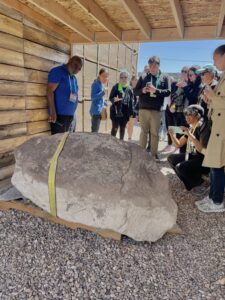
After the ceremony at Topaz, the pilgrimage group boarded the bus and traveled sixteen miles to the handsome Topaz Museum, which opened in 2017 after decades of fundraising and planning in the small town of Delta, Utah. Once there, the pilgrimage group found their way to the back of the museum where we gathered to witness the actual Wakasa Memorial Stone, a one-thousand-pound rock now confined in a small enclosure. After paying our respects to the stone, we toured the Topaz Museum’s exhibits and collections, which include hundreds of artifacts, photographs, and oral histories, as well as 150 pieces of original artwork. The Topaz Museum’s core exhibit explores the complex story of the World War II Japanese American incarceration experience, especially as it transpired at Topaz. The exhibit begins with the racist laws that marginalized early Japanese immigrants, which lead eventually to the mass incarceration of Japanese Americans during World War II. The exhibit extends into the traumatic impacts of their exile, with an obvious focus on the Topaz experience, and it concludes with an examination of the Constitutional violations that the incarcerees were forced to endure. I found the Topaz Museum exhibits to be impressive, interactive, and informative. The pilgrimage group then gathered a final time out back by the Wakasa Memorial Stone before boarding the bus and returning to Salt Lake City.
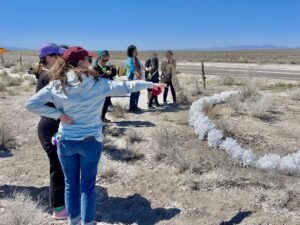
The emotional experiences throughout our time in Utah reminded me of William Faulkner’s line in Requiem for a Nun: “The past is never dead. It’s not even past.” The public history presentations on “historical urgency” at NCPH, the outstanding exhibits on Japanese American artists, the powerful pilgrimage to Topaz and the commemorative ceremony at the site of James Wakasa’s murder, which we shared with survivors and descendants of the prison camp eighty-one years from the date of Wakasa’s death, as well as our trip to the Topaz Museum to see its exhibits and the excavated Wakasa Memorial Stone all reminded us that history is still very much alive and shapes our present experiences. At both the Topaz incarceration site and at the Topaz Museum in Delta, we witnessed some of the still-simmering tensions between Topaz Museum Board members and members of the Wakasa Memorial Committee over what has happened and what will happen to the now-unearthed Wakasa Memorial Stone. Throughout all of those experiences in Utah, I kept thinking on the recurrent theme of “belonging,” including in the oral histories we continue to conduct in the Oral History Center’s Japanese American Intergenerational Narratives Project. “Belonging” carries multiple meanings and invites complex questions. Within what communities, or within which factions of communities, do we find and feel belonging? Throughout history, and up through the present, where have Japanese Americans found belonging? What about the physical artifacts of Japanese American history, like artwork created during World War II-era incarceration, or like the recently re-discovered Wakasa Memorial Stone? To whom do those objects belong? And importantly, who has the right to tell the history of artifacts, artwork, memorials, or lived experiences? To whom does this history belong?
Answers to questions of belonging are elusive because they’re always evolving. I do know, however, how grateful I feel to continue working with individuals and communities to record oral histories that empower narrators to share their own living memories and reflections on the past, and how the personal histories these interviews record will continue to shape our shared present moments. These experiences in Utah helped further inspire our ongoing work on the Japanese American Intergenerational Narratives Project. We hope that you, too, can find inspiration and meaning in these stories, and that they might inform your own sense of belonging.
— Roger Eardley-Pryor, Oral History Center historian and interviewer
ABOUT THE ORAL HISTORY CENTER
The Oral History Center of The Bancroft Library preserves voices of people from all walks of life, with varying political perspectives, national origins, and ethnic backgrounds. We are committed to open access and our oral histories and interpretive materials are available online at no cost to scholars and the public. You can find our oral histories from the search feature on our home page. Search by name, keyword, and several other criteria. Sign up for our monthly newsletter featuring think pieces, new releases, podcasts, Q&As, and everything oral history. Access the most recent articles from our home page or go straight to our blog home.
Please consider making a tax-deductible donation to the Oral History Center if you’d like to see more work like this conducted and made freely available online. While we receive modest institutional support, we are a predominantly self-funded research unit of The Bancroft Library. We must raise the funds to cover the cost of all the work we do, including each oral history. You can give online, or contact us at ohc@berkeley.edu for more information about our funding needs for present and future projects.
Oral History Center Partners in Yale Celebration of James C. Scott
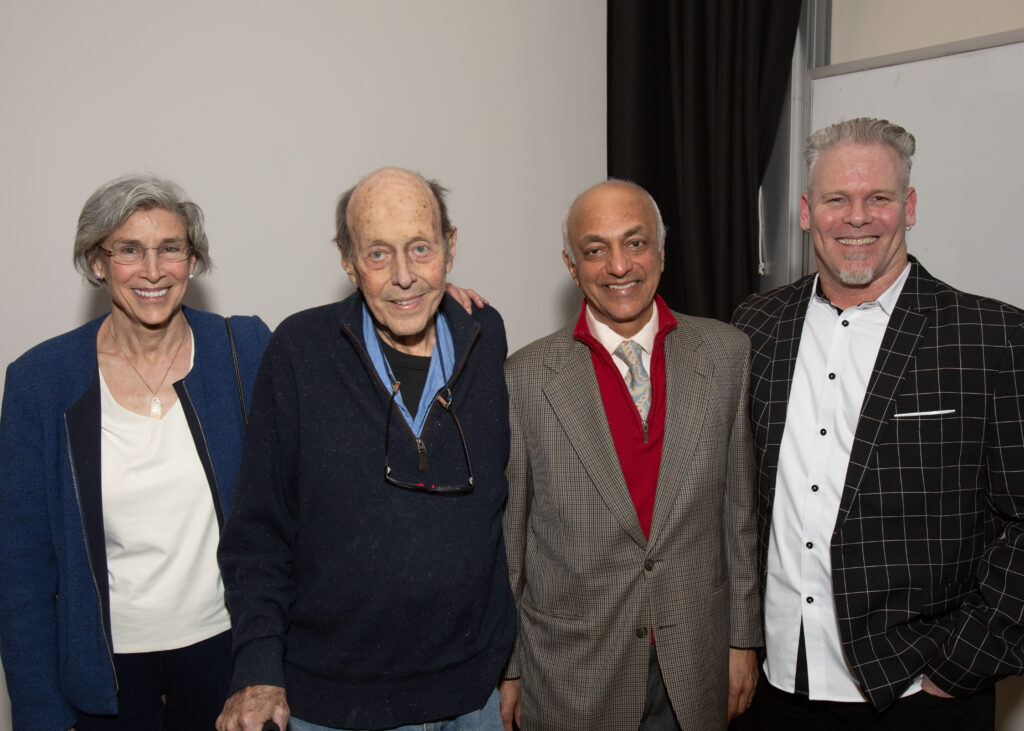
On March 28, OHC historian Todd Holmes participated in the retirement celebration of James C. Scott at Yale University. For many academics around the world, Scott needs no introduction. He is the Sterling Professor of Political Science and Anthropology at Yale University; founder of the renowned Yale Agrarian Studies Program; and author of a series of groundbreaking books that over the decades have become mainstays across the fields of the humanities and social sciences. To be sure, this impressive scholarship not only earned him honors from nearly every corner of the academy, but also made him one of the most influential and widely read social scientists in the world. In 2022, Scott announced his retirement, drawing to a close an academic career that had spanned over five decades.
This past March, scholars and students alike gathered at Yale University to celebrate Scott and his extraordinary career—an event in which the Oral History Center was proud to participate. The OHC began working with Yale in 2018 on an oral history project to document both the career of Jim Scott and the history of the Agrarian Studies Program he founded in 1991. Led by OHC historian Todd Holmes and released in 2022, The Yale Agrarian Studies Oral History Project featured the full life history of Scott and shorter interviews with sixteen affiliates of the program. At the event, Holmes – a Yale alum and former graduate coordinator of the Agrarian Studies Program – presented bound volumes of the oral histories to the Yale University Library. In addition to the oral history presentation, the event also featured a screening of the documentary film, In A Field All His Own: The Life and Career of James C. Scott. Produced by Holmes, the film draws from the nearly thirty hours of oral history interviews conducted for the project to trace the intellectual journey of the award-winning social scientist from his childhood in New Jersey through each of the works he produced in his accomplished career. The film is available to the public on YouTube. It is also linked below.
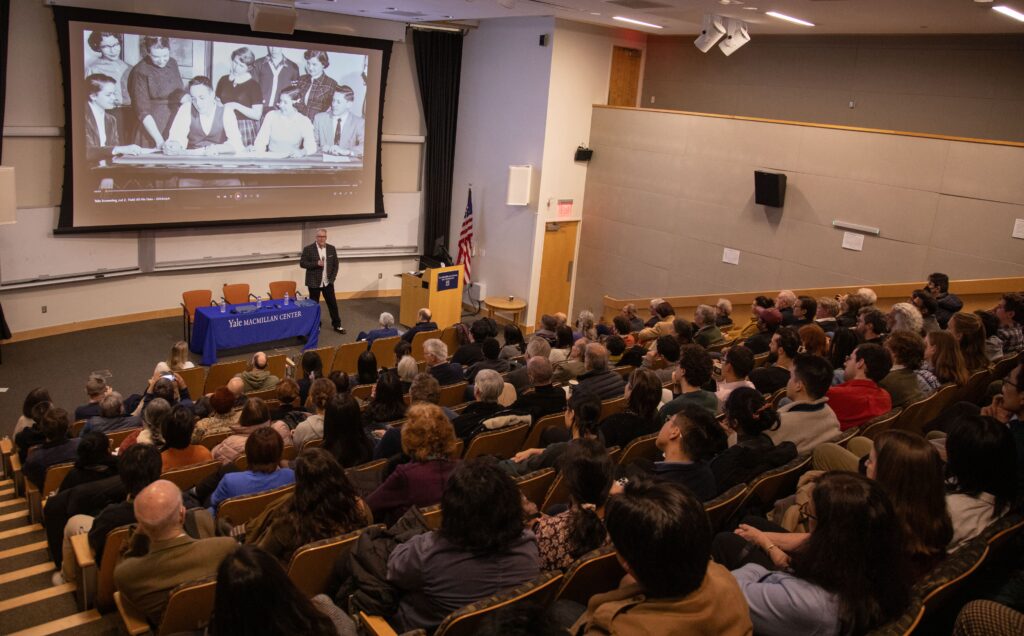
Jim Scott expressed his appreciation for the event in his concluding remarks, noting how much he preferred a celebration of this sort – with film and discussion – over the typical academic retirement symposium, or Festschrift. The latter, in his view, “always seems like a memorial,” he joked with the audience, “and I assure you, I’m still here!” Always the humorist, he punctuated the point by announcing the forthcoming release of his book on Burma’s Irrawaddy River by Yale University Press, another noteworthy achievement for a scholar who turns 88 years young in December. Scott had discussed this project in his oral history, hinting that he still had something to say about rivers before he “hung up his coat.” It was a fitting end for an event celebrating an extraordinary career.
Additional Resources
James C. Scott: Agrarian Studies and Over 50 Years of Pioneering Work in the Social Sciences
Yale Agrarian Studies Oral History Project
About the Oral History Center
The Oral History Center of The Bancroft Library preserves voices of people from all walks of life, with varying political perspectives, national origins, and ethnic backgrounds. We are committed to open access and our oral histories and interpretive materials are available online at no cost to scholars and the public. You can find our oral histories from the search feature on our home page. Search by name, keyword, and several other criteria. Sign up for our monthly newsletter featuring think pieces, new releases, podcasts, Q&As, and everything oral history. Access the most recent articles from our home page or go straight to our blog home.
Wikiphiliacs, Unite! (At our Wikipedia Editathon, on Valentine’s Day, 2024)
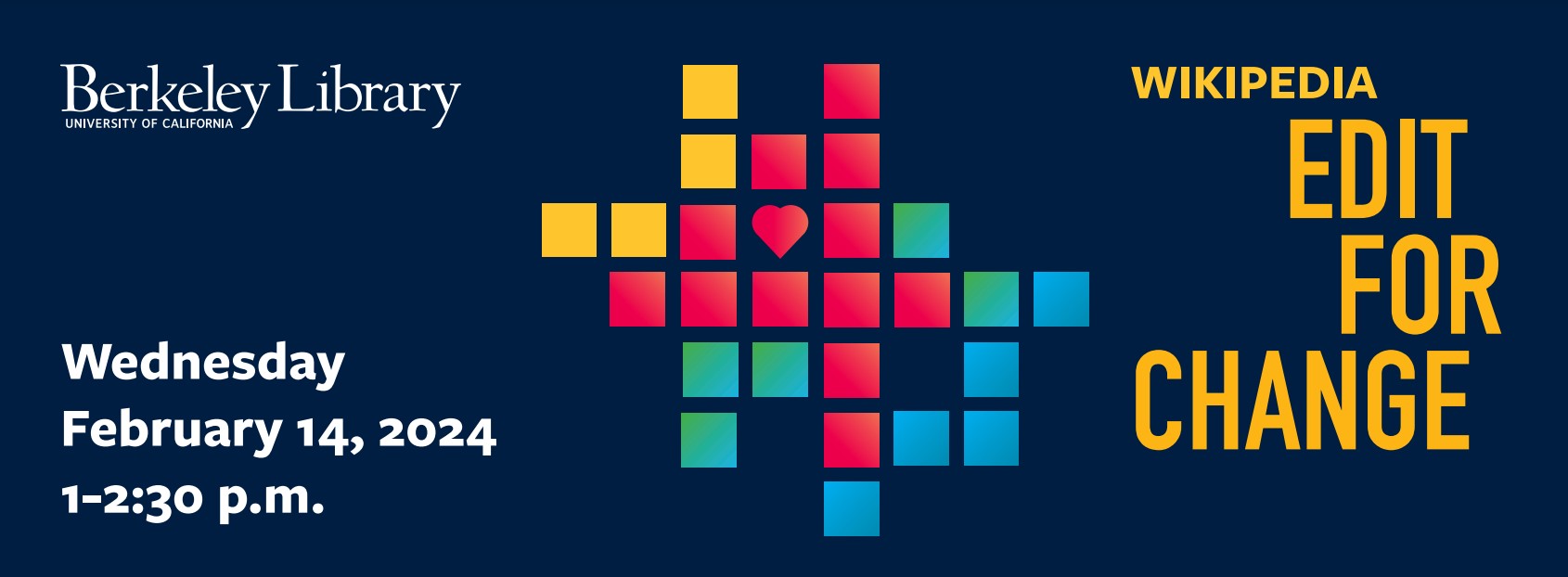
I am a proud Wikiphiliac. At least, according to the Urban Dictionary, which defines Wikiphilia as “a powerful obsession with Wikipedia”. I have many of the signs it warns of, including “accessing Wikipedia several times a day…spending much more time on Wikipedia than originally intended [and]… compulsively switching to other Wikipedia articles, using the hyperlinks within articles, often without obtaining the originally sought information and leaving a bizarre informational “trail” in his/her browsing history” (but that last part is just normal life as a librarian).
How else do I love Wikipedia? Let me count the ways! As a librarian, I always approach crowd-sourced information with a critical eye, but I also admire that Wikipedia has its own standards for fact-checking, and in fact some topics are locked to public editing. It takes its mission very seriously. It also has an accessible and neutral tone. Especially when I want to learn about a technical topic, it can give me a straightforward and helpful way to approach it. I also use it pretty routinely as a way to look at collections of sources about a topic; when I was a medical librarian, I was asked for data on the condition neurofibromatosis, and at that time the best basic links I found were in the references for the Wikipedia article. Last and maybe most importantly, the fact that anyone can edit is a huge strength…with challenges. Wikipedia openly admits its content is skewed by the gender and racial imbalance of its editors, and knowing this is part of approaching it critically, but it also means that IT CAN CHANGE, and WE CAN CHANGE IT.
Given that philia, a word taken from Ancient Greek (according to the philia Wikipedia article), means affection for or love of something, it’s fitting that our 2024 Wikipedia Editathon is part of UC’s Love Data Week, and happens on Valentine’s Day. If you would like to learn to contribute to this amazing resource, and perhaps even help diversify its editorial pool, we can get you started! There isn’t yet a Wikipedia page on Wikiphilia, but maybe you could create one! There already is a podcast series…
If you’re interested in learning more, we warmly welcome you and invite you to join us on Wednesday, February 14, from 1-2:30 for the 2024 UC Berkeley Libraries Wikipedia Editathon. No experience is required—we will teach you all you need to know about editing! (but, if you want to edit with us in real time, please create a Wikipedia account before the workshop—information on how to do that is on the registration page). The link to register is here, and you can contact any of the workshop leaders with questions. We hope you will join us, and we look forward to editing with you!
NOTE: the Wikipedia Editathon is just one of the programs that’s part of the University of California’s Love Data Week 2024! Don’t forget to check out all the other great UC Love Data Week offerings—this year UC Berkeley Librarians are hosting/co-hosting SIX different sessions! Here are those UCB-led workshop links, and the full calendar is linked here:
Thinking About and Finding Health Statistics & Data
GIS & Mapping: Where to Start
Cultivating Collaboration: Getting Started with Open Research
Code-free Data Analysis
Wikipedia Edit-a-thon
Getting Started with Qualitative Data Analysis
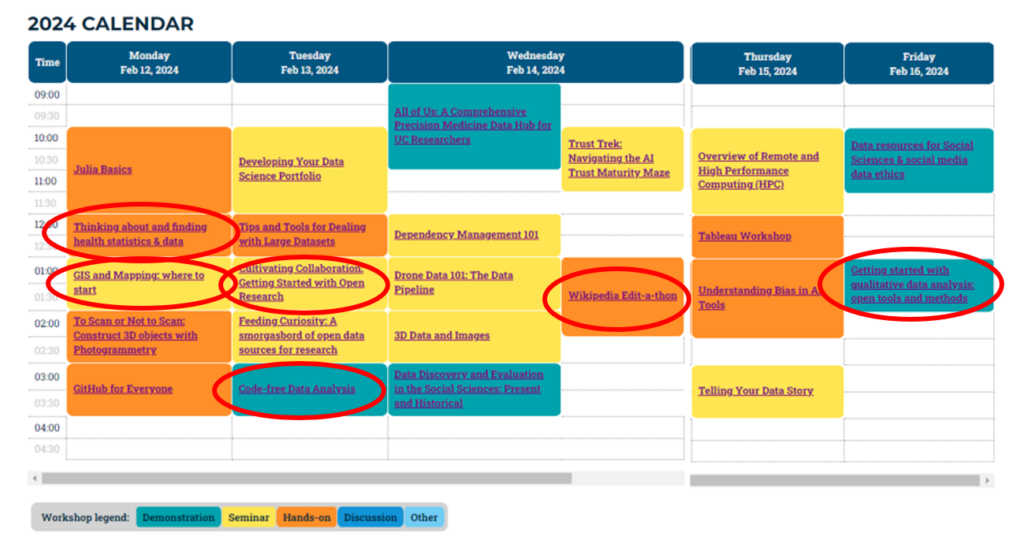
Read OverDrive eBooks and Audiobooks on Mobile with Libby
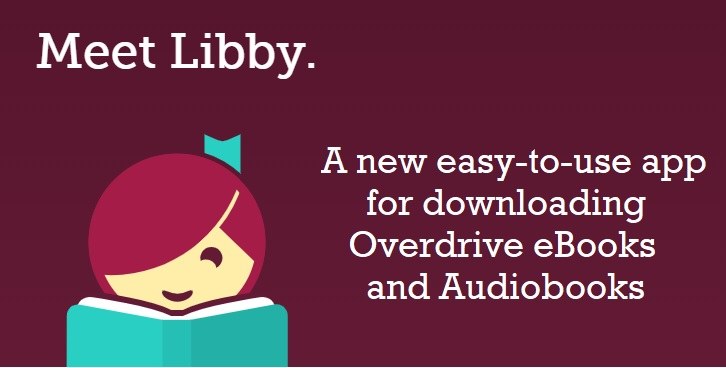
Do you read ebooks and audiobooks on OverDrive? If so, the free Libby app allows you to read and listen on your mobile device. It’s easy to get started. Here’s how.
Step 1: Download the app
-
- Go to your mobile device’s app store.
- Install the Libby app for free.
Step 2: Add UC Berkeley to your list of libraries
- The app will ask you if you have a library card.
- Click “Not Yet.”
- You will be prompted to search for a library branch. Click “Find Libraries Nearby” and then click “No, I’ll Search For A Library”.
- Type in “University of California Berkeley,” and select “University of California Berkeley.” You will be taken to the Library’s OverDrive collection.
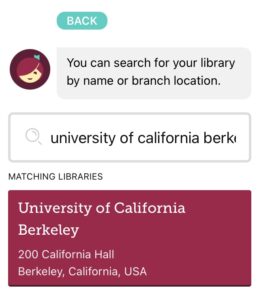
Step 3: Log in with CalNet ID
- Add a library card by selecting “Enter Library Account Details.” You will be taken to the CalNet authentication page.
- Sign in.
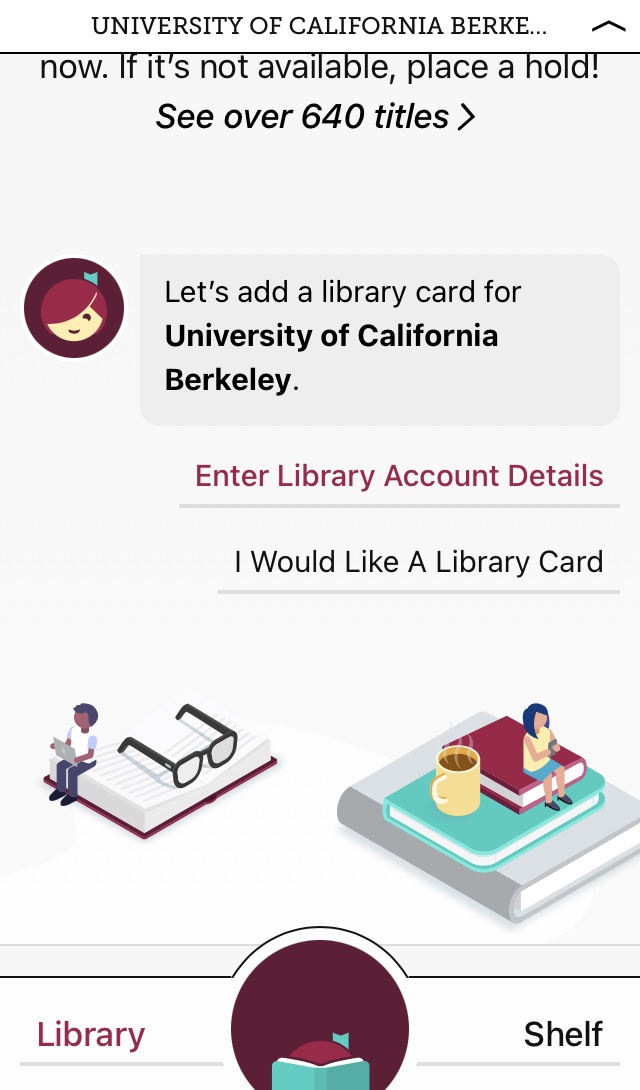
Step 4: Borrow Books!
- To check out a book, select the book and click “Borrow.” (If a book is already checked out, you can click “Place a Hold.”)
- The app will then show you a virtual library card and you will be able to see how many books you have checked out and how many holds you have. You’re all set!
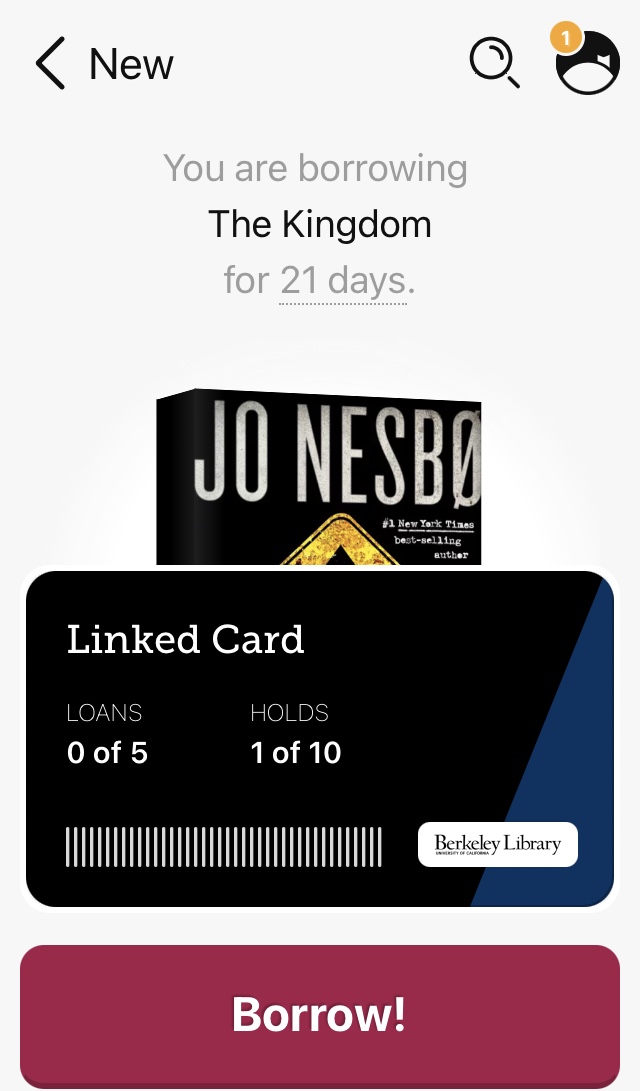
Still using the original OverDrive app? OverDrive is discontinuing it. You’ll want to use Libby instead. Click here for more.
A Conversation About Awe

In his new book Awe: The New Science of Everyday Wonder and How it Can Transform Your Life, Dacher Keltner, UC Berkeley professor of psychology, defines awe as “the emotion we experience when we encounter vast mysteries that we don’t understand.” In his recent book talk, he introduced a receptive crowd to this concept, and how it is distinct from bliss, ecstasy, or gratitude. It is an emotion of mystery, of goosebumps. Keltner has even served as an “awe consultant,” guiding Pixar films on how to incorporate awe in the films Inside Out, and Soul.
When Prof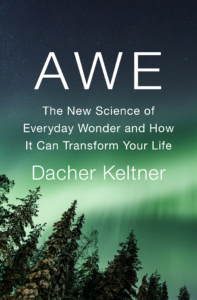 essor Keltner was joined in conversation with three colleagues and an audience of a hundred in the Morrison Library on February 27, the discussion touched on many aspects of this emotion. Yuria Celidwen, a senior fellow at the Othering & Belonging Institute, spoke about transcendent experiences as conceptualized in indigenous cultures and how the elders in her Chiapas, Mexico community teach about a sense of reverence for nature or “ecological belonging.” Wesley Lu, a fourth year undergraduate and a student mental health advocate, spoke about collective effervescence — when a life force creates a collective self whether in a classroom, during a religious ceremony or among sports fans.
essor Keltner was joined in conversation with three colleagues and an audience of a hundred in the Morrison Library on February 27, the discussion touched on many aspects of this emotion. Yuria Celidwen, a senior fellow at the Othering & Belonging Institute, spoke about transcendent experiences as conceptualized in indigenous cultures and how the elders in her Chiapas, Mexico community teach about a sense of reverence for nature or “ecological belonging.” Wesley Lu, a fourth year undergraduate and a student mental health advocate, spoke about collective effervescence — when a life force creates a collective self whether in a classroom, during a religious ceremony or among sports fans.
And no conversation about awe, especially in Berkeley, is complete without a discussion of plant medicine; third year undergraduate Mridini Vijay, also a campus mental health advocate, asked Celidwen to discuss her research on the topic that is commonly, though incorrectly, referred to as psychedelics. In Ethical Indigenous Medicine to Guide Western Psychedelic Research and Practice (The Lancet Regional Health – Americas (February 2023)), which Keltner described as “one of the most important papers on psychedelics ever published,” Celidwen and colleagues discuss concerns by Indigenous Nations over the cultural appropriation and exclusionary practices of psychedelic use in the West and the false notion that plant medicine is somehow the “one key pill to human enlightenment.” In fact, there is evidence that a daily practice incorporating “understanding, kindness, gratitude and reverence” may be as good as or better than psychedelics. In the end, there is so much more to learn about awe, and how we may experience it in our daily lives. Keltner’s book is a wonderful starting point for that journey.
Come Help Us Create Wikipedia and Create Change, Edit by Edit, on February 15, 2023!

Wikipedia has become so central to our lives that we count on it to represent reality, and solid fact. When we encounter a new phenomenon, we check out our trusty online friend for more information. So, it was fascinating to me recently to see the lines blur between fiction and reality, when Wikipedia was used as a visual and social cue in the movie Tár, starring Cate Blanchett, about a famed female conductor. In the movie, one of the clues to the coming turbulence in Lydia Tár’s life is a screen capture of a mystery editor changing items on the conductor’s Wikipedia entry. It looked and felt so real, the filming and Blanchett’s performance so rivetingly vivid, that many people believed the film was a biopic of a real person. As Brooke LaMantia wrote in her article, No, Lydia Tar is Not Real,
“When I left the theater after watching Tár for two hours and 38 minutes, I immediately fumbled for my phone. I couldn’t wait to see actual footage of the story I had just seen and was so ready for my Wikipedia deep dive to sate me during my ride home. But when I frantically typed “Lydia Tar?” into Google as I waited for my train, I was greeted with a confusing and upsetting realization: Lydia Tár is not real…the film’s description on Letterboxd — “set in the international world of classical music, centers on Lydia Tár, widely considered one of the greatest living composer/conductors and first-ever female chief conductor of a major German orchestra” — is enough to make you believe Tár is based on a true story. The description was later added to a Wikipedia page dedicated to “Lydia Tár,” but ahead of the film’s October 28 wide release, that page has now been placed under a broader page for the movie as a whole. Was this some sort of marketing sleight of hand or just a mistake I stumbled upon? Am I the only one who noticed this? I couldn’t be, right? I thought other people had to be stuck in that same cycle of questioning: Wait, this has to be real. Or is it? She’s not a real person?
Wikipedia is central to LaMantia’s questioning! While it’s easy to understand people’s confusion in general, the Tár Wikipedia page, created by editors like you and like me, is very clear that this is a film, at least as of today’s access date, January 20, 2023… On the other hand, did you know you can click on the “View History” link on the page, and see every edit that has been made to it, since it was created, and who made that edit? If you look at the page resulting from one of the edits from October 27, 2022, you can see that it does look like Tár is a real person, and in fact, a person who later went on to edit this entry to make it clearer wrote, “Reading as it was, it is not clear if Lydia actually exists.” Maybe I should write to LaMantia and let her know.
I tell this story to show that clearly, Wikipedia is a phenomenon, and a globally central one, which makes it all the more amazing that it is created continuously, edit by edit, editor by editor. There are many ways in which our own and your own edits can create change, lead to social justice, correct misinformation and more. While it’s easy to get lost in the weeds of minute changes to esoteric entries, it’s also possible to improve pages on important figures in real-life history and bring them into our modern narrative and consciousness. And it’s easy to do!
If you are interested in learning more, and being part of this central resource, we warmly welcome you and invite you to join us on Wednesday, February 15, from 1-2:30 for our 2023 Wikipedia Editathon, part of the University of Calif0rnia-wide 2023 Love Data Week. No experience is required—we will teach you all you need to know about editing! (but, if you want to edit with us in real time, please create a Wikipedia account before the workshop). The link to register is here, and you can contact any of the workshop leaders (listed on the registration page) with questions. We look forward to editing with you!
Coming Soon: Love Your Data, from Editathons to Containers!
UC Berkeley has been loving its data for a long time, and has been part of the international movement which is Love Data Week (LDW) since at least 2016, even during the pandemic! This year is no exception—the UC Berkeley Libraries and our campus partners are offering some fantastic workshops (four of which are led by our very own librarians) as part of the University of California-wide observance.
Love Data Week 2023 is happening next month, February 13-17 (it’s always during the week of Valentine’s Day)!
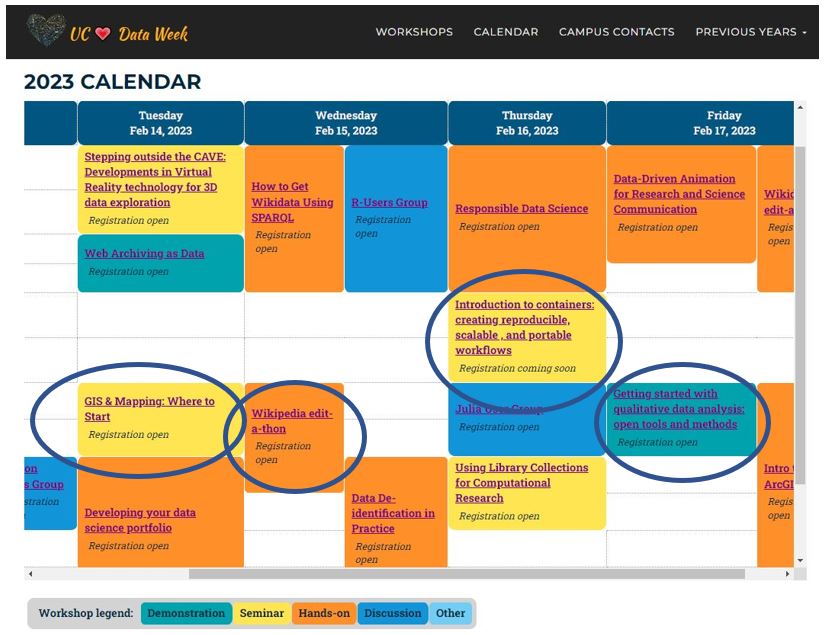
UC Berkeley Love Data Week offerings for 2023 include:
Wikipedia Edit-a-thon (you can also dip into Wikidata at other LDW events)
Textual Analysis with Archival Materials
Getting Started with Qualitative Data Analysis
All members of the UC community are welcome—we hope you will join us! Registration links for our offerings are above, and the full UC-wide calendar is here. If you are interested in learning more about what the library is doing with data, check out our new Data + Digital Scholarship Services page. And, feel free to email us at librarydataservices@berkeley.edu. Looking forward to data bonding next month!
Undergraduate Research Advocates Program
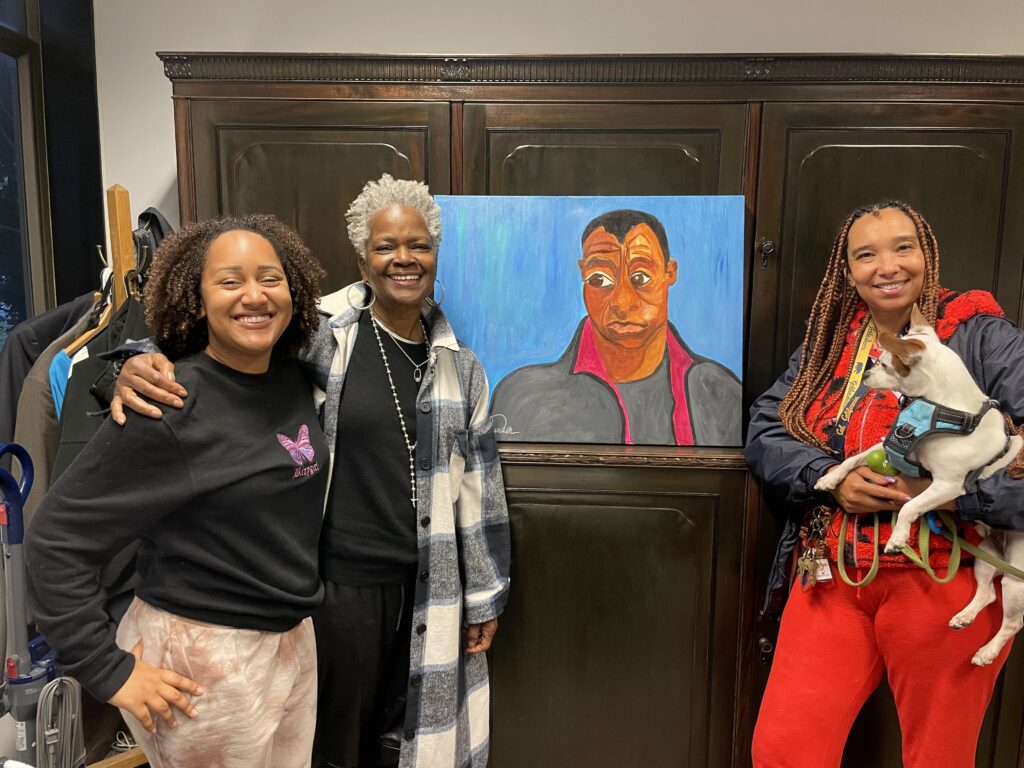
Artist Gaila Patrice Turner with her portrait of James Baldwin. With scholars Tatiana Butte and Amber Griffin-Royal.
The Social Sciences Division’s Undergraduate Research Advocates Program was initiated in spring 2022 by division head Susan Edwards and librarian David Eifler. This small pilot program worked with students from NavCal, the fellowship that assists incoming nontraditional students navigate the Berkeley campus. The pilot provided three NavCal fellows with small research stipends to explore new ways to provide library services to first generation and historically underrepresented students. It was designed to be a collaboration in which student research advocates educate librarians about ways to improve outreach; librarians, in turn, taught in-depth research methods to the students who then became trusted emissaries doing library outreach to communities to which they belong or identify.
Our first cohort — Tatiana Butte, Crystal Swan and Amber Griffin-Royal — was selected from students expressing interest in the internship and with guidance from NavCal Director Dean Tanioka. The cohort met weekly with Environmental Design Librarian David Eifler to improve their research skills and develop ways the Environmental Design Library could be more welcoming to historically underserved communities. As with any pilot, there were failures and successes – hosting a film about Oakland gentrification on a busy night failed to attract anyone. However, acquiring more welcoming art for the Library and incorporating informative posters about women and underrepresented architects and landscape architects has been successful. Perhaps most exciting was Amber and Tatiana’s presentation to NavCal students highlighting key library resources and demonstrating Zotero citation software.
The student research advocates and the librarians learned a great deal in the process: opening new lines of communication, re-exploring the role of the library and the librarian in undergraduate education, making physical improvements to the Environmental Design Library, and establishing new friendships. Perhaps most important, bonds of trust, understanding, and empathy were created that extend to today.
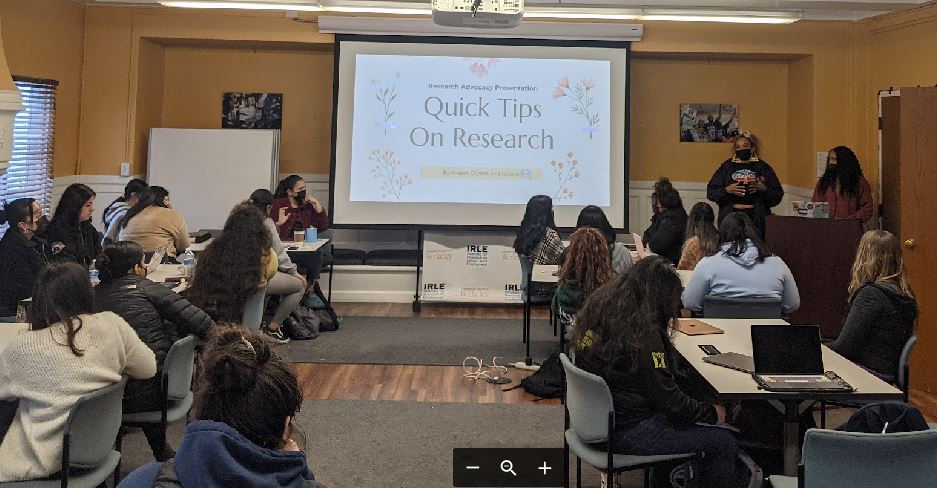
Amber Griffin-Royal and Tatiana Butte provide library instruction to NavCal cohort.
Miracle on 47th Street
You may have searched the library’s new search interface, UC Library Search (now at one year post-launch!), and gotten a result for an item at NRLF, the Northern Regional Library Facility. It’s one of two cooperative storage facilities for the University of California, the other being SRLF, and when you consider that the University of California’s collection is the largest of research universities in the USA, you can understand why storage is a big deal. As a librarian, I’ve always sort of taken NRLF for granted, and certainly had never seen it—until this month, when I was lucky enough, with colleagues from the Social Sciences Division and the Interlibrary Loan department, to take a tour (spoiler alert—don’t miss the video at the end of this post!!!!).
This involved a trek to the Richmond Field Station, where the NRLF sits at the intersection of Meade and S. 47th Streets, just under 8 miles NW of Doe Library on the main campus. While unassuming from the outside, the NRLF complex, which manages physical access to and metadata for items deposited primarily by libraries at the UC’s northern campuses (UC Berkeley, UC Davis, UC Merced, UC San Francisco and UC Santa Cruz), currently holds more than 7.5 million items. The logistical challenges and scale are momentous, and the fact that it is all beautifully organized and our tour hosts were calm and welcoming is miraculous to me (hence the title of this post). Take for example the banner below—3 million items are all in a day’s work for the staff at the NRLF!! (I exaggerate, but not much).

The complex has been constructed in phases, with storage areas corresponding to each. Below is a picture of the Phase 1 area—when I walked into it, I got a hit of the vastness of space that you get in that very last scene of Raiders of the Lost Ark, where the ark is being wheeled into the massive storage area in some government building somewhere (see the picture here– apparently I’m not the only one with this image burned into my brain). In the NRLF’s case, the shelves are all filled with books and other library items, with the difference from the random packing of the movie image being that they are barcoded by location for retrieval, to avoid loss and mis-shelving (as with any large library, if you misplace an item, it may stay lost for a long time). In the NRLF’s Phase 1 picture below, you are seeing just the lowest of four levels going up to the roof. Also note that the spaces are climate controlled, so as better to preserve the items. Any items sent for storage which are not in good condition may be regretfully rejected, since conditions like mold in a book can be detrimental to items nearby. Also notice here the rolling library stairs on steroids that are used to retrieve items from higher shelves (I’ll come back to these below).
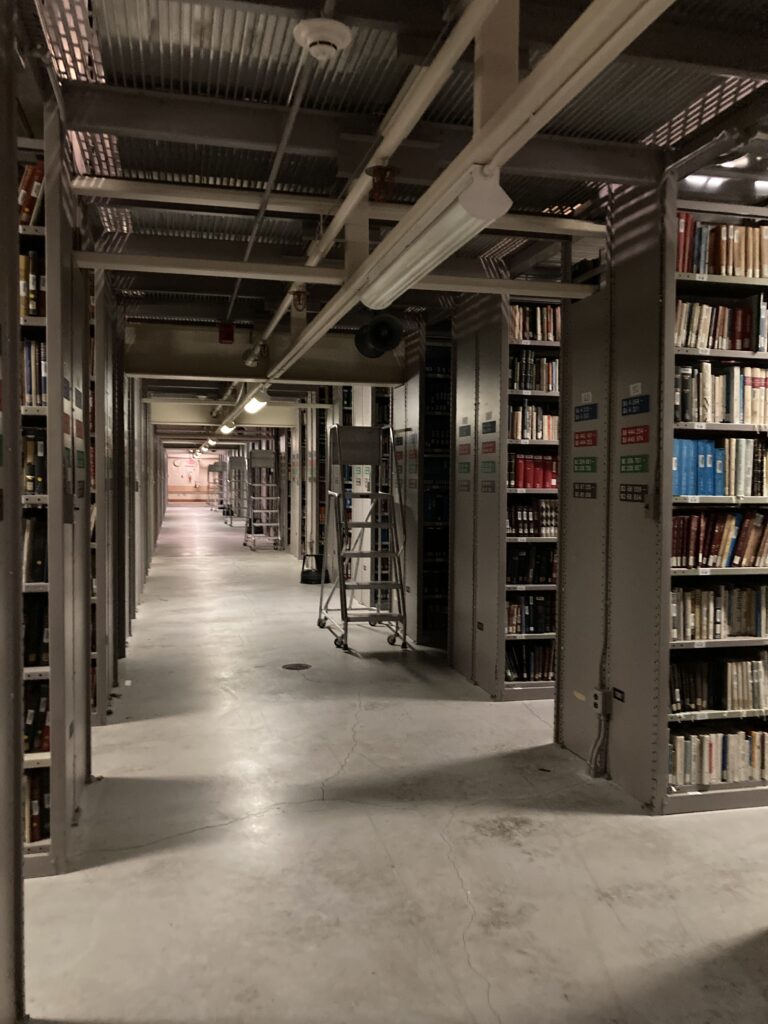
Once I’d gotten my head around the sheer vastness of the spaces and the amazing logistical innovations for managing the spaces and the items (visualize iPads with specialized software, taking into account Wifi availability, staff availability and training, and more), my next impression was just – carts, carts, CARTS! So many carts! Each had a planned purpose and location, highlighting the amount of care and work it takes just to process items being accepted for storage—you aren’t just throwing them onto shelves as you might in your own attic. And, in the picture immediately below, you can see that the items aren’t coming in neatly organized by subject, nor are they eventually shelved that way. Thanks to barcoding technology and software for using it, it’s the location of the item that matters for retrieval, so it’s fine to shelve the book Cancer Detection and Prevention two books away from Glassmaking in Renaissance Venice, as long as you can find each when requested by a library user. This is the difference between browsing a collection organized by subject, and trying to store and retrieve so many disparate items coming at you in random order.
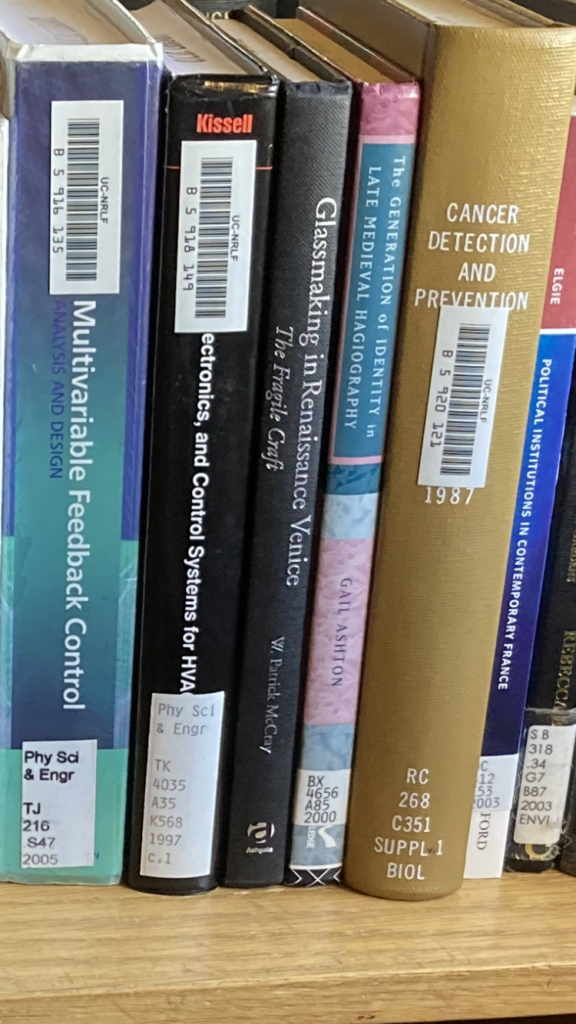
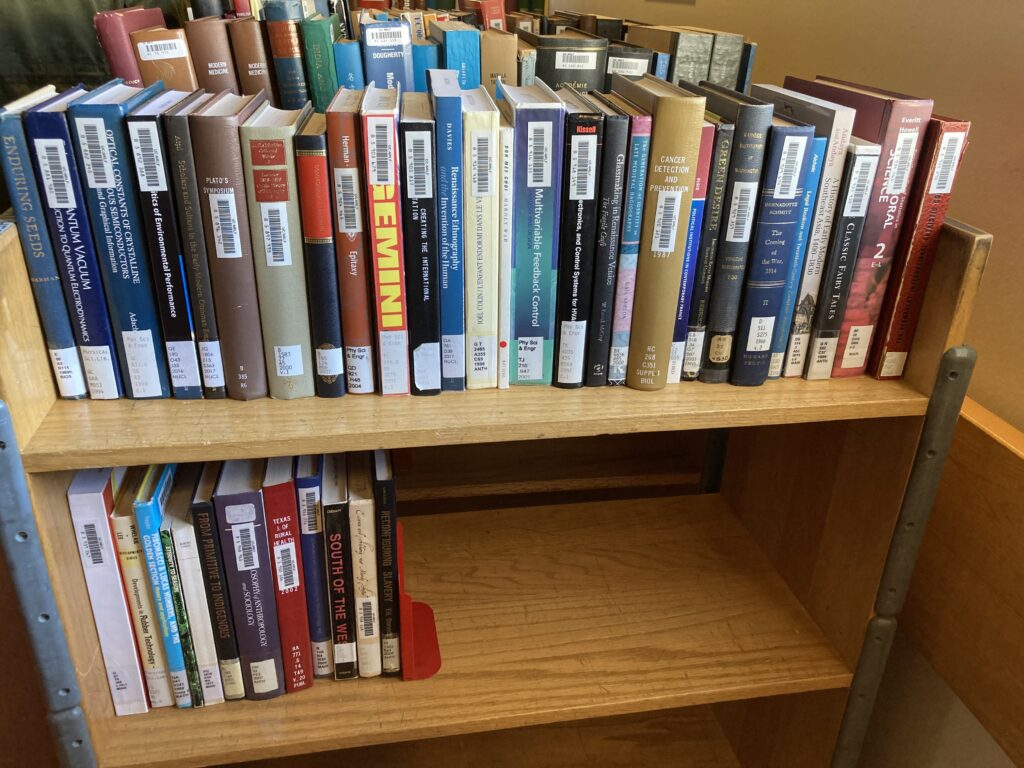
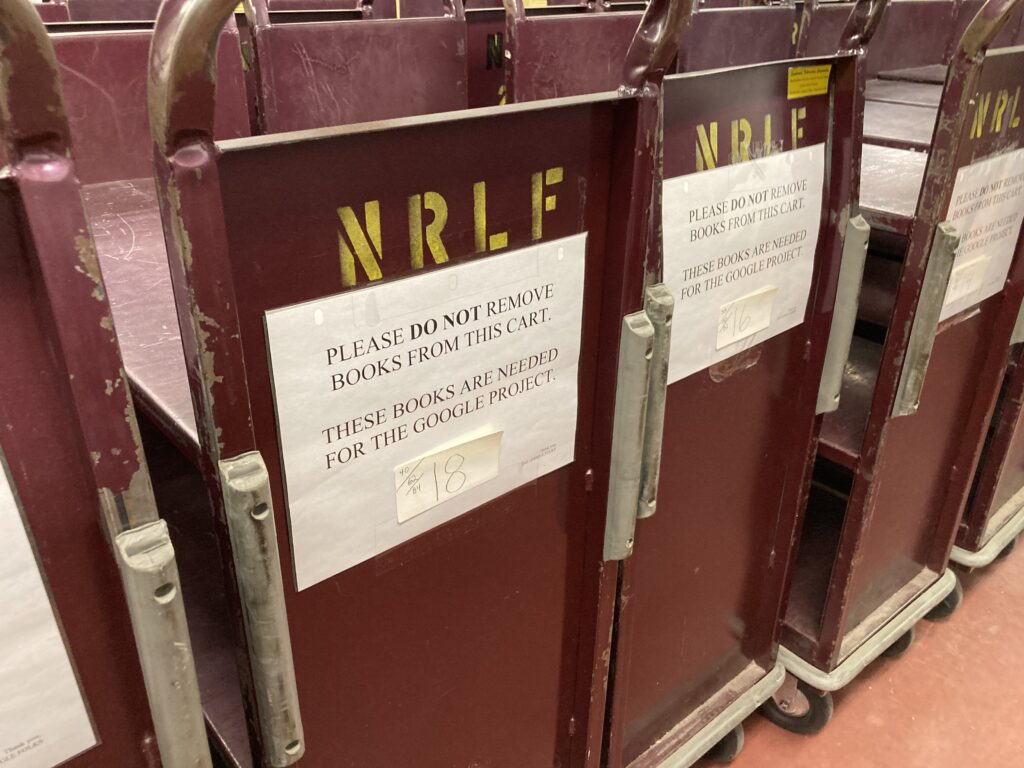
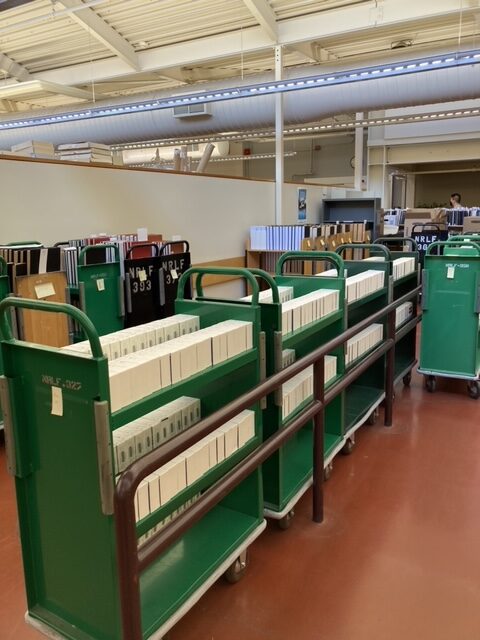
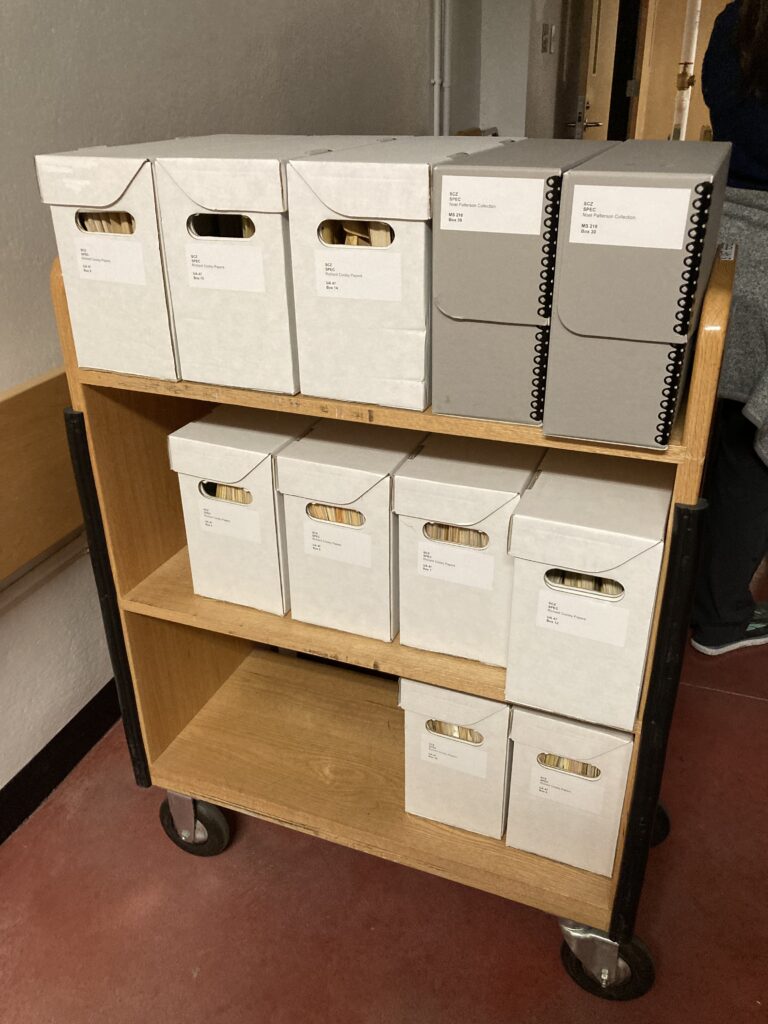
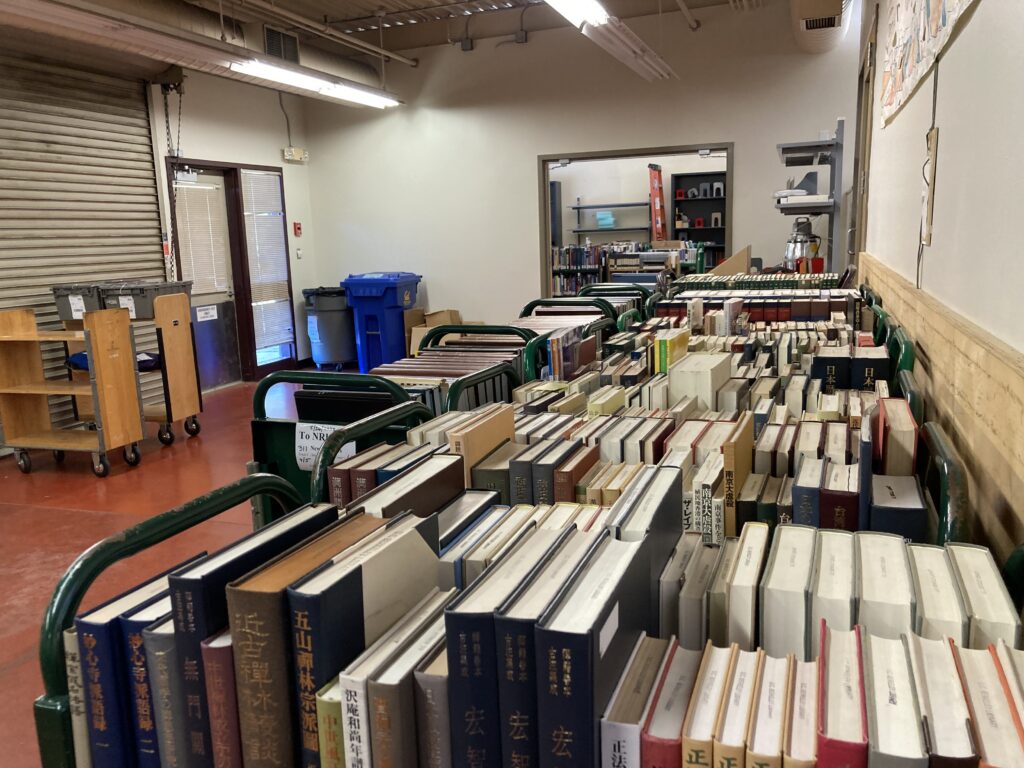
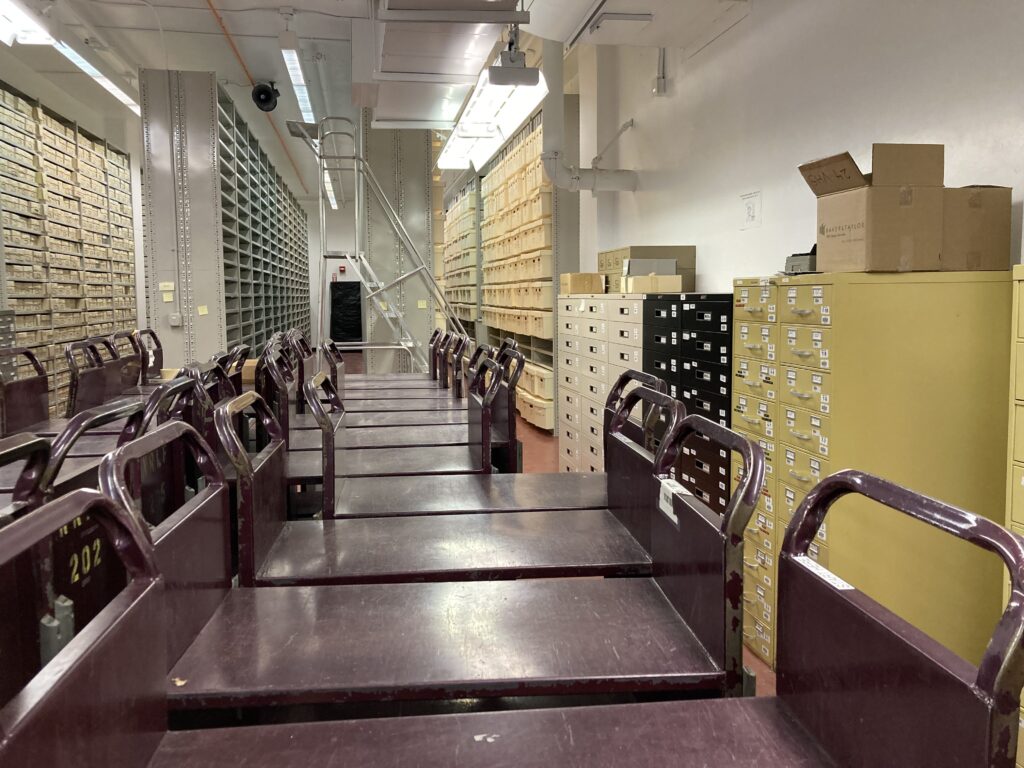
In the picture immediately above, in addition to having carts (natch), notice the varying types of cabinets. This is because while we mostly think about storing books, NRLF actually holds a wide range of item types, including, besides books and journals. “microfilm, maps, audio discs, manuscripts, archives, and other materials”. Here we see the Microforms Room, which holds stored ranges of microfiche and microfilms (at UC Berkeley, a great place to see what these formats look like up close and personal will be when the Newspapers and Microforms Library reopens after its construction-related closure).
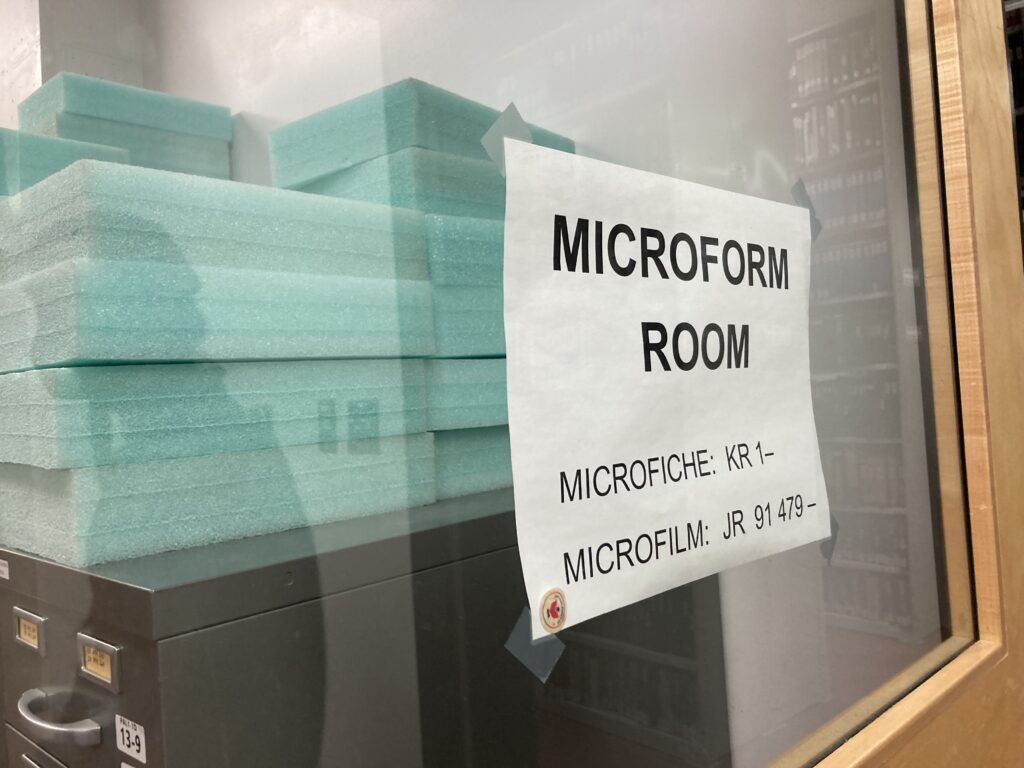
The final stop of the tour was to the Phase 4 building, which will be able to hold 2.5 million items itself, and is in the early stages of being populated with items. It should be able to accommodate storage for the UC system for the next several years, but no worries since the location of the Phase 5 storage area is right nearby for when it’s needed! The pictures below show the large open working space (for now—but surely it will fill up too), and also a diagram for measuring item size so that the space used by the container boxes for the items is maximized (again, this is why it’s great to be able to shelve by location and not subject—you can put all the similar sized items together in a box without worrying that a similarly-themed title is twice the size of the largest book already in that box).
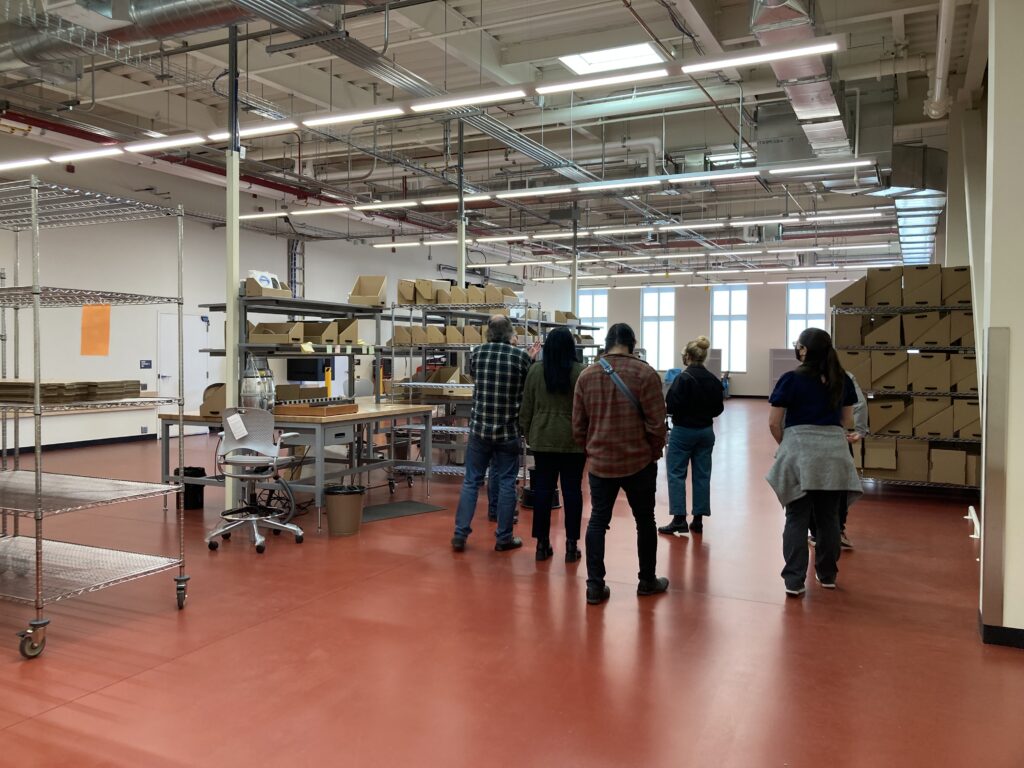
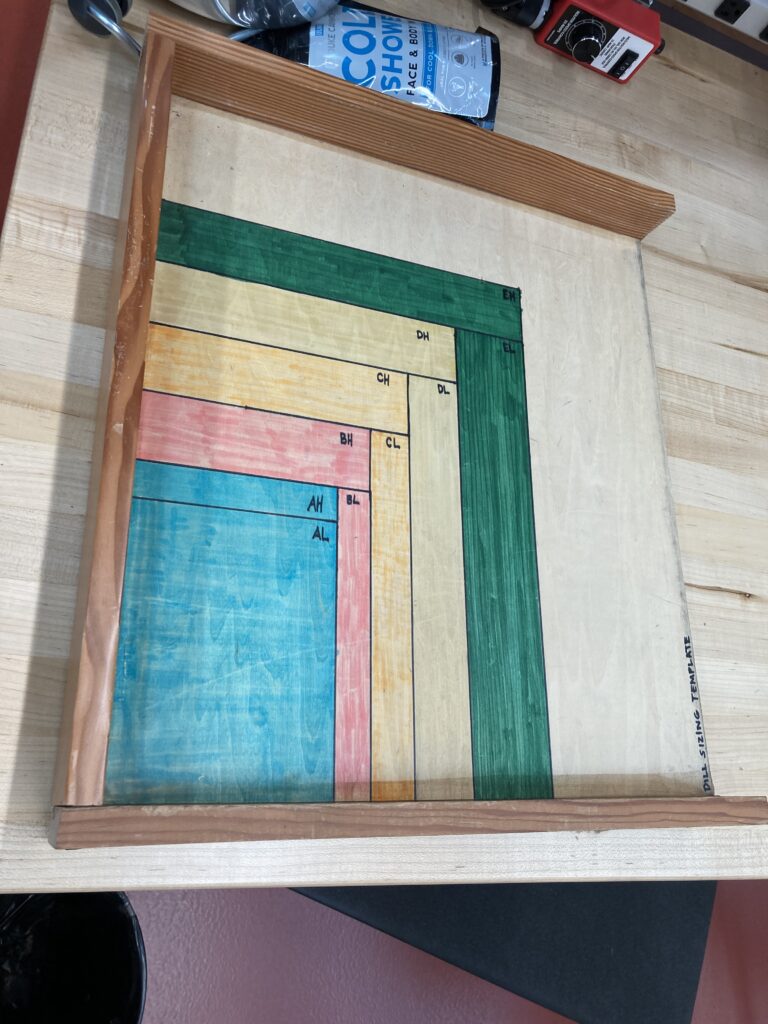
The absolutely most cool part of the tour by far was seeing the machinery that is used for retrieval of items. Remember the picture above from Phase 1, with the library stairs on steroids? This new machinery is not your grandmother’s library stairs—it is next level high tech! In fact, it needs training and certification to be able to use it at all. In the picture below you can see the Phase 4 shelving, and the machine that navigates it for retrieval of items. The machine even has forks at the bottom (similar to those on a forklift) that can carry an entire cart along with it, using the specially made carts with insert points (circled), shown in the second picture below.
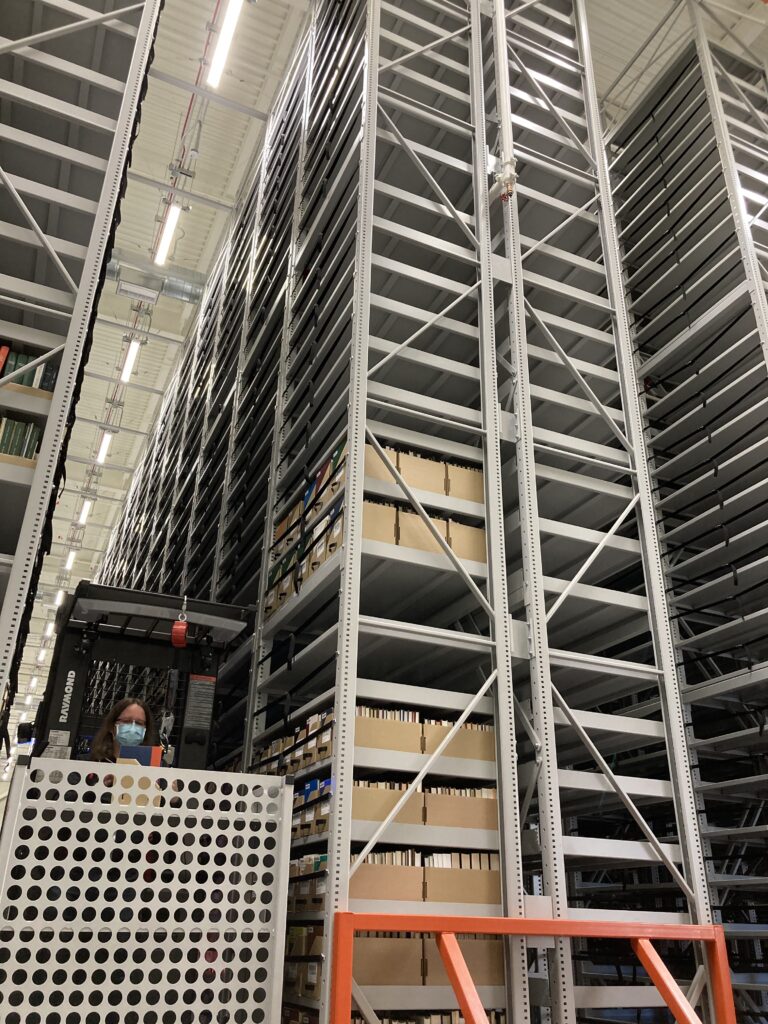
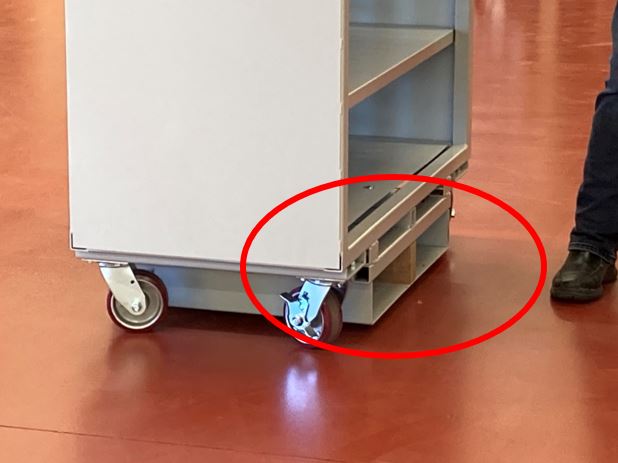
But, actually, this process needs to be seen to be believed! So, here, for your viewing enjoyment, is the video mentioned at the beginning of this post!
As a parting note, the below picture is of an internal exit point from the building. Everyone on the tour (remember that library folks do tend to have some—or a lot—of geek in them) enjoyed the fact that the black stripes on the side of the Phase 4 building represent bar codes used for actual titles in the collection! Our wonderful hosts sent us a list of the titles after the tour, writing:
“Below are the titles whose ISBN barcodes were selected by the SLFB as metal siding patterns for NRLF Phase 4:
- Fiat Lux: The University of California, 1967, ISBN–10: 1125257695 ISBN–13: 978–1125257692
- The art of the book / Charles Holme 1990 edition of a 1914 printing ISBN: 088029504X or 9780880295048 (https://archive.org/details/artofbook00holm)
- It’s a book / Lane Smith ISBN:9781596436060 or 1596436069
- A Brief History of the University of California, University of California Press, 2004. ISBN 9780520938533 0520938534
- The Mountains of California, Modern Library Classics Ed. by John Muir, 978–0375758195
- The Ohlone Way: Indian Life in the San Francisco-Monterey Bay Area by Malcolm Margolin, Heyday Books, Berkeley, CA 1978 ISBN-13: 978-0930588014”
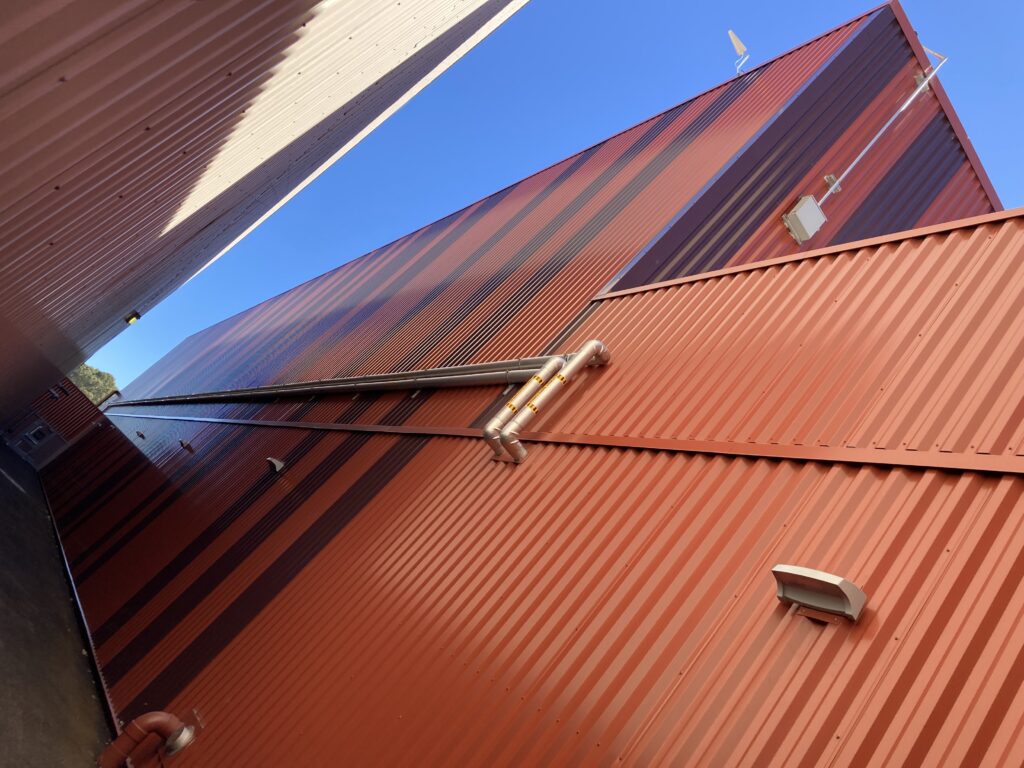
If you’d like to visit the NRLF, there is a reading room open to the public. The stacks are not physically browsable due to how they’re organized, but users can find all items stored at NRLF by virtually browsing UC Library Search. With enough advance notice, materials you need will be prepared and available to use when you arrive. And you will receive a warm welcome, as our tour group did!
The Pot of Gold!
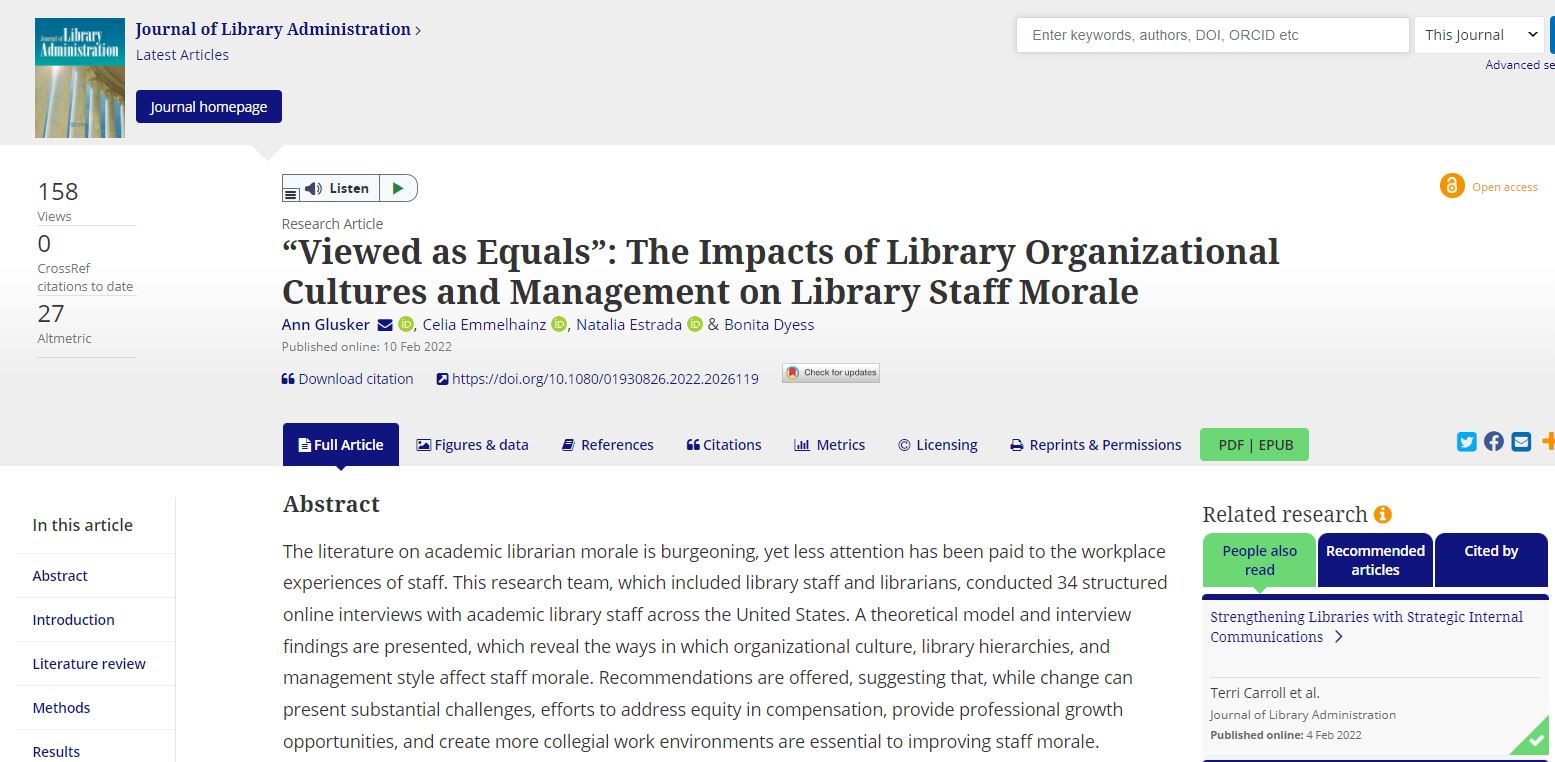
You may have seen an earlier post in this blog about a library research journey, related to a study on the morale of library staff. There is a growing body of work exploring the morale of librarians, but not much on that of library staff, and like any good researchers, our research team (librarians, staff, and former library staff) pounced on the gap in the literature! That earlier post outlines how the project got started, its early phases, and getting to the point of presenting our initial findings. As well as the fact that the interviews and in fact the entire process pretty much happened during a pandemic.
But, when that was written, we hadn’t done any detailed data analysis yet, and we were still a ways away from the ultimate goal of publishing the study, in order to make it widely useful. Well, nine months later (amazingly quickly) that day has arrived—goal met, destination arrived at, pot of gold at the end of the rainbow, in hand! The paper has been published! Here’s what happened between then and now.
First, we actually got invited to submit the paper, by the editor of the Journal of Library Administration. That was pretty exciting in itself, and surely is largely due to the above-mentioned lack of research on this topic. Next, came the actual analysis of the transcripts of the interviews, conducted with library staff nationwide, using the qualitative data software MAXQDA. Using a tool such as this helps ensure that there is rigor in extracting the themes from the content, and I can testify that this process brings up themes and patterns you might not otherwise expect or extract! Then, because of the choice to use a research method called grounded theory, it was important to develop a theoretical model of what had evolved (this happens after extracting the themes). That brought up even more relationships and connections to consider!
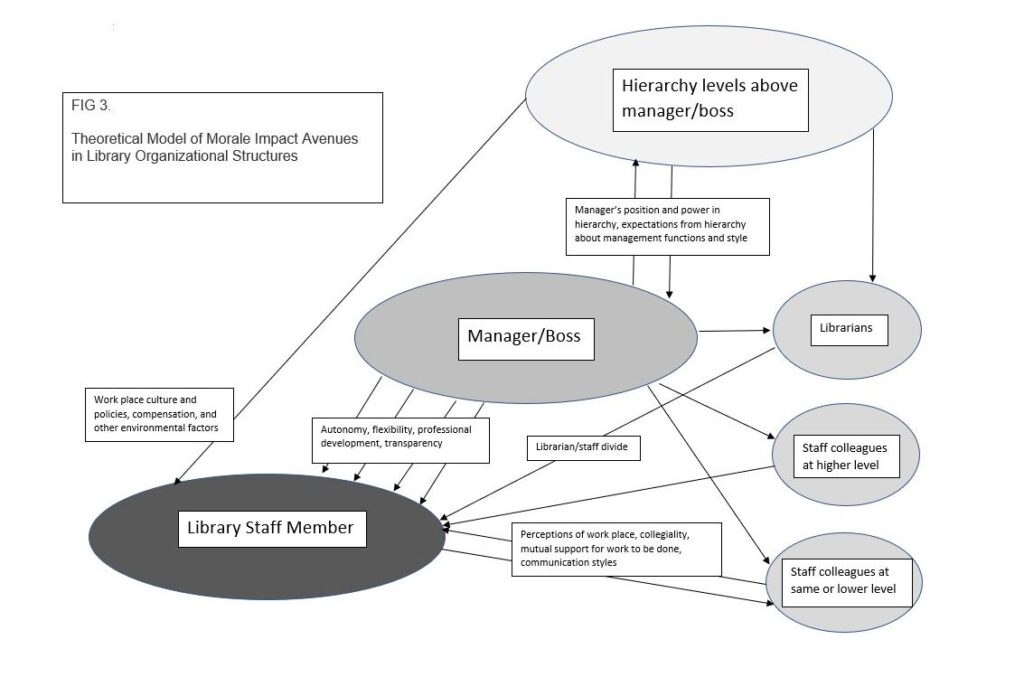
At this point—time to write. Not in order—it was easiest to warm up with the introduction and methods sections, and actually the discussion and conclusion sections came next, since we’d already presented on the material and had a sense of what those would look like. After that came the literature review. Yikes, we had a Zotero library of more than 90 articles, of which 62 made it into the paper as references. That was a lot of synthesizing! But it also meant we could confidently say that we believe this is the very first in-depth qualitative study of the morale of library staff, which makes us feel that our work may be able to help libraries create positive changes for staff in library settings. By the way, using the citation management software Zotero, that reference list of 62 was populated in Word instantaneously, a far cry from the hours I spent typing the references for my dissertation on a typewriter!
Finally came the results section, the core of what we had found out, which notably includes many quotes representing the lived experiences of our 34 wonderful respondents. And, while this is not commonly done, it made sense to include not just ideas for directions for future research, but also some of the broader questions needing to be answered, that came from the wisdom of attendees at our presentations. There are also appendices with everything anyone would need to recreate our study. Which we very much hope someone will do, in the new post-COVID normal.
Next—the maze of submission to the journal: forms, making sure that author guidelines were strictly adhered to, and similar. And the waiting! It takes time to send a paper to be peer reviewed, to get and address the comments and resubmit, and get a final acceptance. But that all happened, and along with it, the chance to exhale after two years of work.
An important final detail involved whether or not the paper could be published open access, that is, freely available to ANYONE who clicks on it, whether or not their library carries the journal title. Publishing open access would be one way to honor our amazing 34 respondents, meaning that library staff who need to see and think about these issues can download immediately. But, the out of pocket cost to us from the journal (called an article processing charge, or APC) would be $3085. Impossible. Given that price, it would have to be OK to just deposit the pre-print in the UC’s eScholarship portal, and it could be found that way. But then we learned that UC Berkeley authors, through an agreement between the California Digital Library and the publisher, could get a 75% discount on the APC—almost exactly what we had left in our research funding from LAUC! So, now on the upper right of the article’s landing page you can see that beautiful, beautiful open access logo. If you are reading this, you can read the article too!

We hope you’ll take a look, and send comments and questions our way, to librarystaffmorale@berkeley.edu. Thanks for reading this, and celebrating with us!
